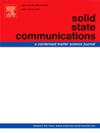环保型钙钛矿基光电探测器中红光探测能力的增强及低光灵敏度的提高
IF 2.4
4区 物理与天体物理
Q3 PHYSICS, CONDENSED MATTER
引用次数: 0
摘要
本文提出了一种以氧化锡(SnO2)为电子传递层、磷化锌(Zn3P2)为空穴传递层、甲基溴化锡(CH3NH3SnBr3)为吸收层的高性能光电探测器的设计方案。钙钛矿吸收层表现出很强的光收集能力,特别是在低强度照明下,确保增强光子吸收和提高电荷载流子产生效率,从而促进在昏暗条件下产生优越的光电流。该光电探测器在610 - 690nm波长范围内表现出优异的性能,在光下的响应率为0.48 a /W,最大探测率为8.5 × 1014 Jones,突出了其对红光的特殊灵敏度。在可见光范围内量子效率(QE)超过95%。利用SCAPS-1D软件对所提出的设计进行优化,提高了器件的整体性能。结果表明,材料的合理选择、层厚的优化和缺陷的减少是提高光电探测器光电性能的关键。本文章由计算机程序翻译,如有差异,请以英文原文为准。
Enhanced red light detection in eco- friendly perovskite-based photodetector with improved low- light sensitivity
The design of a high-performance photodetector using a combination of Tin oxide (SnO2) as the electron transport layer, zinc phosphide (Zn3P2) as the hole transport layer, and methylammonium tin bromide (CH3NH3SnBr3) as the absorber layer has been proposed in this work. The perovskite absorber layer exhibits strong light-harvesting capability, particularly under low-intensity illumination, ensuring enhanced photon absorption and improved charge carrier generation efficiency, thereby facilitating superior photocurrent production in dim-light conditions. The photodetector exhibits excellent performance within the 610–690 nm wavelength range, achieving a responsivity of 0.48 A/W under light and a maximum detectivity of 8.5 × 1014 Jones, highlighting its exceptional sensitivity to red light. The quantum efficiency (QE) exceeds 95 % in the visible range. The optimization of the proposed design is conducted using SCAPS-1D software, enhancing the device's overall performance. The results indicate that the strategic selection of materials, optimization of layer thicknesses, and reduction of defects are crucial for enhancing the optoelectronic performance of photodetectors.
求助全文
通过发布文献求助,成功后即可免费获取论文全文。
去求助
来源期刊

Solid State Communications
物理-物理:凝聚态物理
CiteScore
3.40
自引率
4.80%
发文量
287
审稿时长
51 days
期刊介绍:
Solid State Communications is an international medium for the publication of short communications and original research articles on significant developments in condensed matter science, giving scientists immediate access to important, recently completed work. The journal publishes original experimental and theoretical research on the physical and chemical properties of solids and other condensed systems and also on their preparation. The submission of manuscripts reporting research on the basic physics of materials science and devices, as well as of state-of-the-art microstructures and nanostructures, is encouraged.
A coherent quantitative treatment emphasizing new physics is expected rather than a simple accumulation of experimental data. Consistent with these aims, the short communications should be kept concise and short, usually not longer than six printed pages. The number of figures and tables should also be kept to a minimum. Solid State Communications now also welcomes original research articles without length restrictions.
The Fast-Track section of Solid State Communications is the venue for very rapid publication of short communications on significant developments in condensed matter science. The goal is to offer the broad condensed matter community quick and immediate access to publish recently completed papers in research areas that are rapidly evolving and in which there are developments with great potential impact.
 求助内容:
求助内容: 应助结果提醒方式:
应助结果提醒方式:


